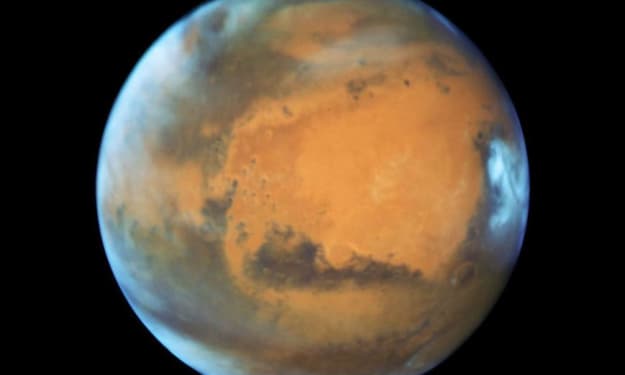Potentially Hazardous Asteroids
Near Earth Objects

The term potentially hazardous objects (PHOs) means near-Earth objects (NEOs) like meteoroids, asteroids, and comets whose orbits will come very close to the orbit of the Earth. Meteoroids are composed of minerals and rock and have a diameter of less than one meter. Comets are composed of dust and ice. Meteoroids with a diameter of greater than one meter are called asteroids.
Most asteroids' orbits are between the orbits of Mars and Jupiter. Ceres, Vesta, and Pallas are the three largest asteroids known to exist. Ceres is the largest with a diameter of about 946,000 meters, Vesta is second with a diameter of about 525,400 meters, and Pallas is third with a diameter of about 512,000 meters. The largest known PHO is (53319) 1999 JM8, but it is not predicted to come closer than the 0.05 AU that is the accepted minimum PHO distance this century. It did come within 0.033 AU in 1990.
The abbreviation AU means astronomical unit, which is the distance from the Earth to the Sun (93 million miles). Another abbreviation for a distance commonly used for PHOs is LD, the distance from the Earth to the Moon (238,856 miles).
Asteroid 1566 Icarus was discovered in 1949 by Walter Baade. It has become a famous PHO. It came fairly close to the Earth on June 16, 2015. It is about 1,400 meters wide.
The asteroid 2012 TC4 has been calculated to come very close to the Earth on Columbus Day October 12, 2017, sometime between 5:30 a.m. and 9:30 a.m. The part of the atmosphere called the exosphere of the Earth reaches at least 6,200 miles above the surface of the Earth. Objects are still gravitationally held to the Earth at this distance. The asteroid 2012 TC4 has a minimum predicted distance of coming as close as .0000880453517512432... AU. In miles, this is about (93,000,000 miles x .0000880453517512432 = 8188.2177128656185 miles, it will be only two thousand miles out of the exosphere. But even the maximum distance is well below the maximum PHO distance of .05 AU (0.00164202117532665 AU. The velocity also needs to be taken into account. The relative velocity of 2012 TC4 to the Earth is about 7 km/sec. Since the escape velocity for the Earth is about 11 km/sec, this might be a problem, but the distance asteroid 2012 TC4 is from the Earth at closest approach will increase the minimum escape velocity.
There are more asteroids that will come close to the Earth this year and several years in the future.
On October 22, 2017, the asteroid 171576 (1999 VP11) will come closest to the Earth at about 11:02 a.m. It is a very large asteroid, estimated to be between 510 meters and 1.1 kilometers. The Jet Propulsion Laboratory gives it the same nominal, minimum, and maximum distance from the Earth.
It is 0.014832066411 AU, or (93,000,000 miles x 0.014832066411)= about 1,379,382 miles. Although it is farther away than the moon, it is still about one-fifth the PHO minimum.
On Halloween (October 31, 2017), 171576 (1999 VP11), another very large asteroid, will have a maximum distance from the Earth of 0.03847 AU. This is about (93,000,000 x 0.03847 = about 3,577,710 miles. It is almost 15 times the distance to the Moon, but it is still less than the PHO of about 19 LD.
One of the asteroids that will be largest and comes closest to the Earth will be 99942 Apophis (2004 MN4). It was named after the Egyptian god of evil and destruction. Its size is estimated to be between 310 meters and 680 meters. Its closest approach to the Earth will be 0.00025 AU, or 0.10 LD.
One-tenth of the distance from the Earth to the Moon is (1/10) x 238,856 miles)=about 23,885.6 miles. Its velocity relative to the Earth will be 7.42 km/sec.
There are two impact hazard scales that are used to calculate the probability of an impact with the Earth. They are the Torino scale and the Palermo scale. For the Palermo scale, a score of less than minus two means that no impact is expected. A score of between minus two and zero merits careful monitoring.
Scores greater than zero are expected to be of a more serious nature, and the position of the asteroid in the sky must be closely watched. The Torino scale is similar to the Palermo scale, but it is not as useful to professionals in the field. The Torino scale is used to communicate with the public. It uses 0 for no risk to 10 for an expected impact of a large asteroid.
About the Creator
Danny Fleming
I received a Bachelor of Science in Mathematics in 1996. I have written several sonnets. I also wrote How to Prove The Collatz Conjecture and Many Articles on Many Subjects.






Comments
There are no comments for this story
Be the first to respond and start the conversation.